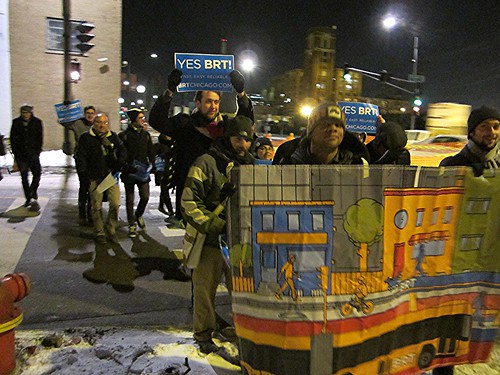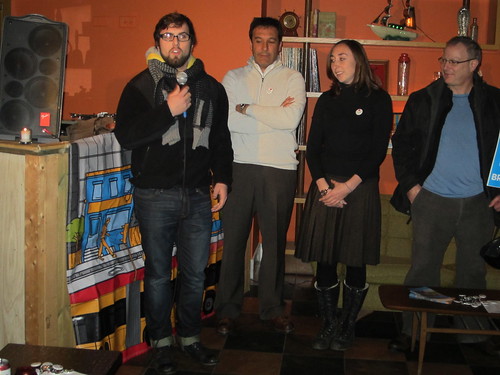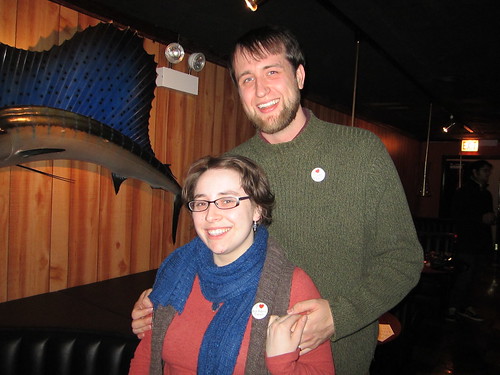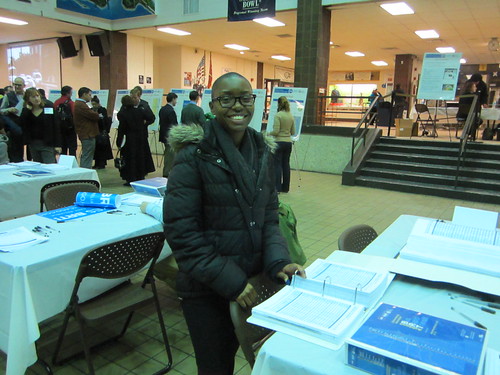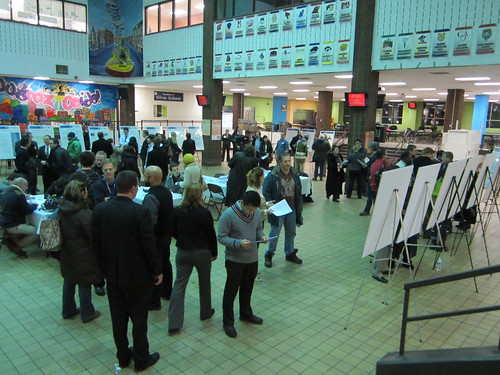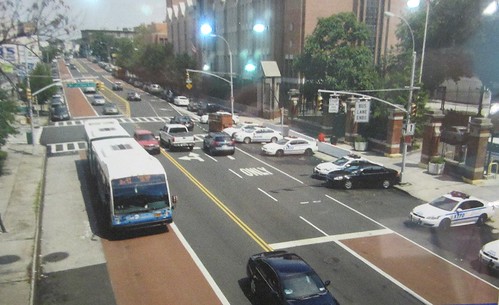Proponents of effective public transportation made a strong showing at last night’s South Side hearing on the city’s plan for bus rapid transit on Ashland Avenue. Dozens of people showed up for an Active Transportation Alliance rally beforehand at the Punch House tavern, 1227 West 18th in Pilsen. Then they marched to the open house at Benito Juarez Community Academy, 1450 West Cermak, where supporters seemed to far outnumber opponents of the plan.
A few speakers addressed the crowd at the bar. Dennis ONeill, director of the Near West community organization Connecting4Communities said his group endorses BRT because plenty of development is already slated for the area. “The Illinois Medical District has a lot of plans to develop the vacant land around the medical district, one of the largest medical districts in the country, while we have 90 acres in Roosevelt Square, one of the largest Hope VI redevelopments of federal public housing in the country,” he said. “Ashland Avenue goes right through both of those, so it’s very important to our community that we have efficient, innovative transportation.”
Pilsen resident Michael Whalen told the audience BRT will help him move around the city more efficiently. “I’m looking forward to a bypass to get around downtown when I’m trying to go visit people on the Northwest Side,” he said. “Getting to the Blue Line will be a lot faster. I have friends around Midway Airport – getting out there is going to be a lot easier too.”
William Duncan, the bar’s manager, told me BRT will bring more customers. “Anything that makes it easier for folks to get to other parts makes sense to me,” he said. “I think it will be great for our business. Pilsen is a wonderful community of cultural significance. There’s a lot of things to do here. Folks from the North Side to the South Side ought to be able to access our neighborhood easily. Rapid transit along Ashland would certainly help with that.”
Attendee Toby Schwartz said fast buses will make it easier to explore new neighborhoods. “I feel like a lot of times we end up getting trapped in our own little neighborhoods, our own kind of tiny little spheres, mostly because it takes so long to get somewhere else, because transit can be such a hassle,” she said. “So to be able to get really quickly to a different part of the city is really exciting. You can go more places and see more things.”
Holding “Yes! BRT” signs aloft, the group walked a few blocks through the snowy streets to the high school. There, residents could peruse display boards about the project, page through weighty binders with graphs and charts, talk with CTA staffers, fill out comment sheets, leave notes about their concerns on a giant map of the entire corridor, and give testimony to a court reporter. Although the room was full of people, there seemed to be a relatively low turnout of civilians, probably due to the frigid temperatures rather than a lack of publicity, since the CTA did a good job of getting the word out. I didn’t notice any members of Roger Romanelli’s anti-BRT group the Ashland Western Coalition.
Grad student Courtney Cobb, thumbing through one of the thick environmental assessment binders, said she supports the plan, which would nearly double bus speeds, even though it would reduce car speeds by ten percent. “BRT reduces travel times for commuters, so I’m all for anything that makes taking the bus faster,” she said. “I don’t really see any negatives, even though it would add a little bit of time to my commute, because I do have to drive for my work. I still support the project 100 percent.”
However, Erin Lowery, a doctor who lives near Ashland and Grand, said she’s apprehensive about BRT. “I’m very concerned with the plan being presented,” she said. “I think it needs a lot more vetting before they change major infrastructure in the city and upset the lives of many of our residents.” Her office is located in west suburban Maywood. “I don’t have the option of giving up my car and taking CTA, like what they’re proposing that people do once this is implemented.”
Of course, no one is suggesting that Ashland BRT is going to replace all car trips, certainly not east-west ones. But 31,000 people currently ride the Ashland bus every day, and that number is expected to increase by almost 50 percent once the system is implemented. Many of those will be folks who choose to leave their cars at home, since the buses will become comparably as fast as driving, minus the expenses and headaches. People like Lowery, who feel they truly need to drive, will still be free to do so, but fewer vehicles on the road will make it easier for everyone to get where they need to go.
Ted Orosz, director of long-range planning for New York City’s MTA, who flew in to work the display boards, said his city’s experience with implementing Select Bus Service, an express bus service on multiple corridors, should make Chicagoans feel more confident BRT will succeed here. SBS buses run in dedicated lanes and the system features prepaid boarding and double-long buses with multiple entrances. The Chicago system will inclide those features, but it will run even faster than SBS because the buses will be center running with level boarding platforms.
Orosz said that Webster Avenue in the Bronx, where a new SBS line was launched this summer, increasing bus speeds by about 30 percent, has a very similar layout to the Ashland plan. Webster has two bus lanes, two mixed-traffic lanes, and curbside parking, although the buses run curbside and left turns are permitted. “It’s the same width as Ashland, 70 feet,” he said. “When I drove Ashland with [CTA staffers] I just had this powerful Webster Avenue déjà vu. It was like, man, this is creepy. These two streets look a lot alike.”
However, unlike Ashland, Webster doesn’t have many parallel alternatives, and its bus ridership is lower at 20,000 boardings per day, which is why the MTA opted against doing center-running buses with left turns eliminated, Orosz said. “We don’t have a pure grid like Chicago in the Bronx,” he said. “Because it would be hard for motorists to go to the next north-south street, it was decided that we didn’t want to go with that radical a change to street operations… But if this street had twice as many buses I think we probably would have come down on the side of the center median.”
Mike Brockway, from the driver advocacy blog The Expired Meter, mentioned the Active Trans rally in a post about the event and reported that “supporters clearly outnumbered detractors” at the hearing. However, Rosalind Rossi from the Sun-Times, whom I observed angrily talking with CTA officials during the open house, didn’t mention the rally at all. Instead she devoted roughly half of her article to complaints from big box store managers who kvetched that they hadn’t received enough notice about the plan from the CTA. Rossi’s coverage of the pro-BRT viewpoint was limited to a single South Side rider, Derrick Williams, who received about three-and-a-half lines of text.
